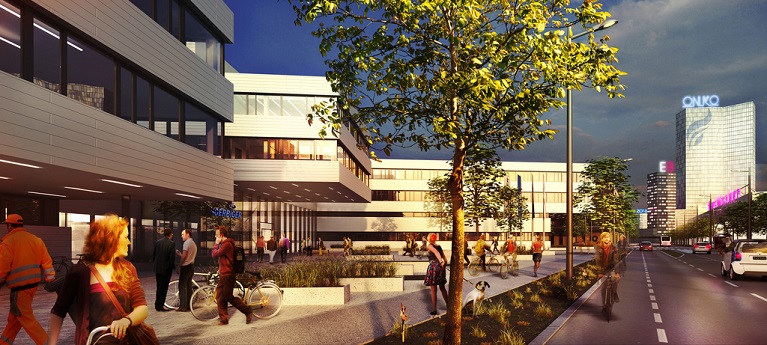Smart City Wien has developed an innovative method to manage surface run-off of rainwater, in which chloride-contaminated water flows into the sewer system while cleaner run-off seeps away naturally into the ground via infiltration basins. Vienna’s dual model thus feeds a proportion of the rainwater back into the natural water cycle. The system is suitable for all public thoroughfares that are connected to the sewer network and have sufficient space available for infiltration basins. A working group consisting of several municipal departments of the City of Vienna and a team from the University of Natural Resources and Life Sciences Vienna (BOKU) carried out initial testing of the model with a pilot installation in Edith-Piaf-Straße at aspern Seestadt. In 2016, the City of Vienna was presented with the Vienna Engineering Award for the dual model.
Roll-out at Seestadt
A large-scale rainwater management system based on the dual infiltration model is being installed for the first time in the “Lakeside Crescent Quarter” at Seestadt, due for completion in 2022/23. In this project, a porous water retention layer (consisting of coarse gravel mixed with humus) is being installed underneath the entire road surface. Here again, the chloride-contaminated water is directed into the sewer system while the remaining surface run-off seeps into the coarse gravel layer, which serves as a water reservoir for the roadside trees and vegetation. Surplus water not required by the trees and plants percolates into the groundwater, thus closing the cycle in this further evolution of the dual model. The dual model also significantly improves living conditions for plants in the urban environment.
Beneficial for groundwater levels and the urban climate
In line with the goals of the Smart City Wien Framework Strategy, the project improves the urban climate by feeding clean rainwater back into the natural water cycle, thus helping to maintain groundwater levels. At the same time, however, it also allows modern standards of snow and ice clearance and serves as a flood protection measure by relieving the burden on the sewer system during heavy rainfall.
Previous rainwater management systems either direct surface run-off straight into the sewer system or redirect it into infiltration basins without separating the waste water. This first dual model was developed by Municipal Department MA 28 – Road Management and Construction in partnership with Municipal Department MA 42 – Parks and Gardens, the aspern Seestadt development agency Wien 3420 Aspern Development AG and landscape architects 3:0. Further project partners include Municipal Dept. MA 45 – Water Management, Municipal Dept. MA 48 – Waste Management, Street Cleaning and Vehicle Fleet, and Wien Kanal – Vienna Waste Water Management. The NGO LandschafftWasser is monitoring the project to document the impact on vegetation and groundwater.
Contact
Municipal Department 28 – Road Management and Construction
E-Mail: post@ma28.wien.gv.at
Website: www.wien.gv.at/verkehr/strassen/
This post is also available in: German




